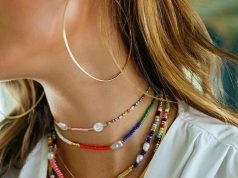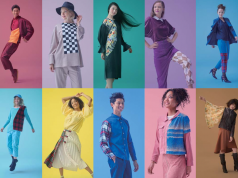JETRO Cairo organizes a networking event for 12 Fashion and Design–related Egyptian companies and organizations with a Japanese leading exhibition organizer, H.P. France.
Well-deserved recognition has come for a batch of innovative Egyptian designers. Three marketing experts from H.P. France, a leading Japanese company in the field of Tradeshow, Retail, Wholesale, Production, Consulting, PR in fashion and life style as well as Arts Support, visits Cairo to discover Egyptian talents and products which would fit with the criteria and the concepts of their unique exhibitions held in Tokyo such as “rooms”.
Cairo West Magazine attended the networking event by JETRO Cairo and caught up with Tomonori Matsui, Executive Director of PR01., H.P. France’s in-house agency specializing in Promotion, Distribution, and Production as well as with some of the designers who seek for opportunities to exhibit in Japan.
CWM: How long has “rooms” been taking place?
H.P. France had been established in 1985 in Tokyo and it launched a fashion and design tradeshow “rooms” in 2000. The show has been an exciting, important launch pad for designers from diverse countries wanting to introduce their unique products into the Japanese market. Visitors come from various countries, especially the Far East and Asian region, so exhibitors are able to reach a very broad market.
We are here in Cairo to find designers and products which could fit with our concepts.
What products does H.P. France deal with and what items could be exhibited at “rooms”?
H.P. France engages in various businesses that relate to lifestyle and culture from fashion, interior to art. In retail, we operate nearly 80 boutiques dealing in European accessories, cutting edge fashion, interior and art. In wholesale, we introduce brands from Europe as well as North and South America to customers.
Regarding “rooms”, there are various exhibit categories. More than half of them is related to fashion accessories, interior items and food.
Does the idea of having something unique rather than mass produced appeal to the Japanese consumer?
Yes, they appreciate uniqueness and this is what we are looking for. The quantity doesn’t matter, it’s the quality that does.
What do you think would appeal to Japanese market, having seen what Egyptian designers produce?
From what we saw we believe that every brand has an edge and is unique in its own way. For instance, the bags we saw that represented Egyptian culture would be sought after in the Japanese market.
What support has JETRO offered in terms of helping local designers to enter the Japanese market?
In January 2016, JETRO (Japan External Trade Organization) organized an evaluation meeting for Egyptian fabric-related products in Tokyo where we attended as one of the participants. After the meeting, we proposed Egyptian side to consider their participation in “rooms”. To exhibit, applicants need to pass our screening. We received an invitation from Egyptian side through JETRO and we are here for screening. JETRO thus connected us with the Egyptian designers by organizing this trip and arranging the meetings with them.
What is your overall impression on Egyptian products?
Egypt has a great history, and its designers are very talented. We are now selecting the most appealing products that would sell in Japan. There is great potential for Egyptian designs and creations to have an impact in the Japanese market.
Malaika
CEM: Do you think the artisan element in your bed linen will be a good selling point in the Japanese market?
M: Yes, having been there before, we found that the Japanese loved the stories behind the designs and were very impressed with the craftsmanship.
Do you see a trend in the global market for more individualized products rather than mass-produced lines?
Definitely. Even locally, looking different is more impressive than looking the same. That is a huge selling point for artisan products and designs.
Heba Linens
CEM: What are your strongest selling points for your products?
HL: Our consistently high quality and customization of designs.
Had you already started exploring export possibilities before being in contact with the Japanese market?
We already export to the Gulf region, and around 90% of our clients are foreigners.
Cotton Ball
CEM: What gives your cotton products a competitive edge in the huge t-shirt market?
CB: When you get the basics right, you know that you can do well. >>
We focus on quality materials, a good cut and use only long staple Egyptian cotton. And of course, we pay a lot of attention to the finishing of the products.
What prompted you to participate in the networking event with H.P. France?
Our brand has been built from the ground up with the export market as a target. Taking the brand abroad has always been an end goal. Equally, Japan is a market that understands and demands quality, and that’s what we stand for.
Siwa Creations
CEM: Have you already seen a positive reaction to your products through Japanese and Asian visitors to Egypt?
SC: Yes, they love our products and find them both unique and appealing.
How important will it be for the small community that creates these items to have a new export market?
It will provide more jobs, which is vital for them.
Nature Tex
CEM: Do you think that having products that made from organically produced Egyptian cotton will be a unique selling point with the Japanese market?
N: Yes for sure, the delegation from PRO1 liked our products and said they have a lot of potential in the Japanese market.
What types of products are you exhibiting?
A diverse range: from garments to carpets, and even dolls.
Markaz
CEM: Is this the first time Markaz has approached the Japanese market?
M: We launched in October 2010, and first time we reached out to the Japanese market was Tokyo in 2012, then again in June of 2013.
Do you expect to find that JETRO would be helpful in making the contacts you need to develop export opportunities?
Yes, definitely. This meeting has been a great opportunity to link with key players in the trade show arena, and we are looking forward to participating in ‘rooms’.
Nuniz
CEM: What are the challenges in finding a good retail outlet in a new market for such unique one-off items?
N: The challenges are in finding markets that appreciate the work that goes into the process of design and innovation while providing a high quality finished product that meets the expectation of an international market
What products from your range do you think will appeal most to the fashion-forward Japanese market?
We believe the Japanese market appreciates innovative design that reflects our multicultural background while using high quality natural leather and exceptional finishing.
Turath
CEM: Japanese culture embraces a tradition of hand-weaving and skilled craftsmanship. Will this help in introducing your products?
T: Of course it will, since familiarity with any handcraft supports creativity across cultures.
Have you opened up export avenues in other areas yet?
Yes, in the UK, USA, France, Italy, Canada, Dubai and now we are awaiting Japan.
Tanis
CEM: Will you be creating any new designs in your textile range to appeal directly to the Japanese market?
T: Yes, we would like to add some new designs to inspire them.
How easy is it to setup an export business for an Egyptian product to a new market?
You can face many challenges to do so, it is not easy but we are always up to that challenge. We always like to work as hard as we can to open up new business opportunities.
Zagh
CEM: What do you think will appeal most about your design ethos to the Japanese shopper?
Z: The cultural inspirations that are presented in a contemporary design. We have learned the Japanese wearer appreciates the story behind the piece but demands quality and comfort.
What direction is jewelry design going in internationally?
ZAGH is not in a position to discuss international trends. We focus more on creating timeless pieces that are worn regardless of fashion trends.
S.A.D.A.F.A.
Have you had interest in your exclusive range of bags from other export markets?
S: This is the first formal approach, although I’ve had previous interest shown by other boutiques.
How do you expect your designs to be received in the Japanese fashion market?
We feel that our Kimono bags will match traditional Japanese dress and costumes. Our design ethos will be attractive to a Japanese market interested in minimalism.
A.P.E. (The Association For The Protection Of The Environment)
CEM: How are you helping the zabaleen community?
A.P.E.: What we do in the zabaleen community could be duplicated in any marginalized community. We have the facility to train people to develop skills and produce handmade goods to increase their income.





